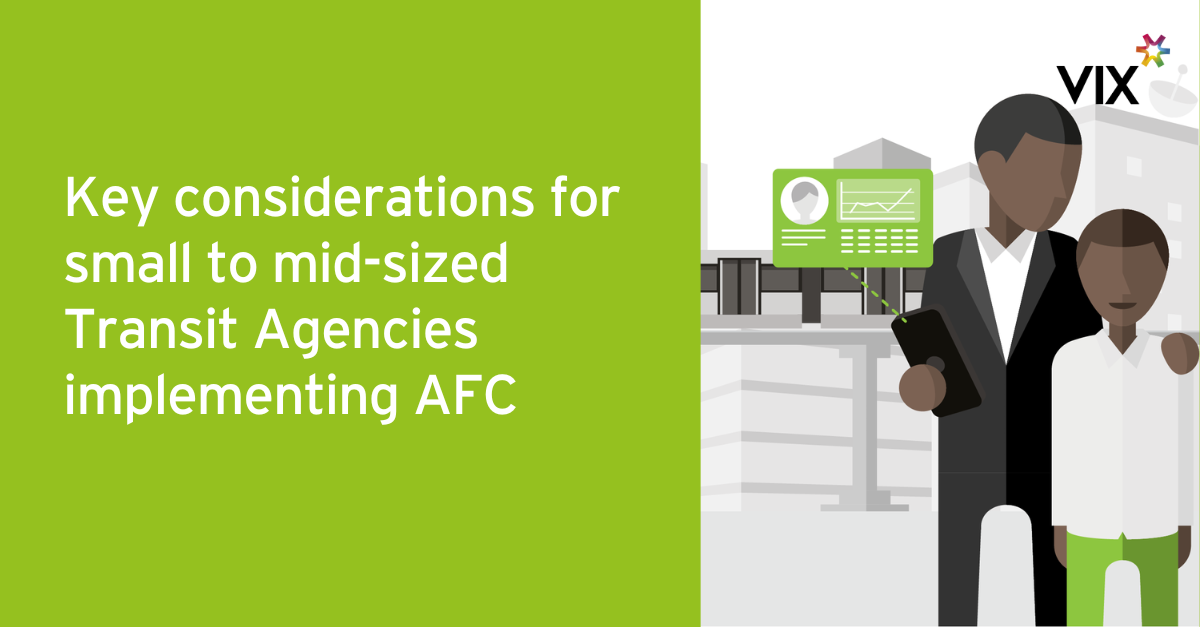Six considerations for small to mid-sized agencies implementing automated fare collection
22 August 2023, USA
During this month’s APTAtech conference, Eric Reese, Vix Americas’ Managing Director, moderated a panel discussion on Automated Fare Collection for Small- to Mid-Sized transit agencies.
Following on from participating in this panel discussion, we outline six key considerations for small and mid-sized transit agencies looking to implement AFC solutions.

1. What to integrate and what to replace?
When thinking about AFC procurements, it’s important to consider the components of the existing fare collection solution, and whether these should be replaced, or integrated with a new system. For example, agencies often choose to keep their existing fare boxes to maintain cash payments, while introducing additional forms of fare payment through a separate AFC procurement.
2. Leverage the power of regional partnerships
Small- to mid-sized transit agencies should consider leveraging regional partnerships. By joining forces with neighbouring agencies, they can increase their purchasing power and deliver a fare payment solution that creates a more seamless payment experience for riders across a region, rather than across the area covered by a single transit agency.
By combining resources and budgets, a regional transit collective can tap into the same AFC services and technology used by large transit agencies.
3. Prioritize of the ‘must-haves‘
To ensure as many responses as possible from vendors and enable flexibility to choose the best solution, agencies should prioritize requirements (Mandatory vs. Nice-To-Have). They must take care to define their business objectives, rather than issuing highly specified technical requirements, which may restrict vendor participation and competition.
For example, if the transit agency has a business need for a solution to be cloud-hosted, highly available and scalable; this is more helpful than asking for a solution hosted in Microsoft Azure cloud.
4. Prepaid or pay-as-you-go fares, or both?
Transit agencies today benefit from the innovations of account-based fare systems to enable a range of fare media options for riders, including closed-loop smart cards, open-loop EMV payments, and mobile tickets (QR code or NFC-based).
In general, AFC systems can support prepaid passes (rider-activated, time-based mobile tickets), and Pay-as-you-go fares with fare capping and automatic best fare calculation.
Prepaid tickets are a good option for a low-cost, rapid mobile app launch, but pay-as-you-go offers security through electronic validation, and rider flexibility to get the same fares through capping across smart cards, EMV payments, and mobile tickets.
Transit agencies should consider which fare structures best serve their business needs and the needs of their riders, and set out what should be delivered and when. That said, a strong AFC solution can support multiple models in parallel, if needed.
5. Build a realistic plan for delivery
Another key consideration when deploying an AFC system is the impact of timeline dependencies.
When developing a project timeline, it’s important to ask a lot of questions. Such as, are riders going to need to get new smart cards? Or, how long will it take to migrate fare products and card balances into the new system? Or, are there imminent new service launches that will require new fare validation devices (Bus Rapid Transit, Light Rail extension, etc.)? Transit agencies, AFC vendors and other stakeholders can work through these questions together to devise a realistic plan for delivery.
6. Communicate to boost early adoption
Modern AFC systems can be deployed and launched in a matter of months (compared to the years it took to deploy legacy card-based solutions). Integration to existing technology or branding of customer websites may lengthen delivery times, but often the standardized core system can be launched quickly, with custom features and functionality rolled out in later phases.
Transit agencies must support the roll-out with strong internal and customer communications and marketing. By educating staff and riders on how to use the system, and the benefits it can bring, they can drive early adoption. As more riders experience the speed, convenience and simplicity of the new fare payment experience, this drives repeat-use and positive feedback within the community.
These are just a few areas for agencies to consider when planning for their next AFC solutions. Interested in learning more about Vix’s AFC offering? Contact us to find out more.
Vix Automated Fare Collection (AFC) solutions enable agencies and operators to deliver a streamlined ticketing experience to passengers, giving them access to the best value fares and the most convenient payment and token options for their journey.
